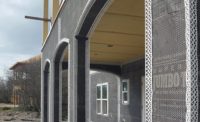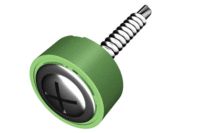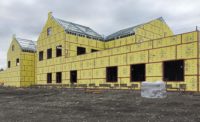As today’s building structures change their exterior façade, one of a number of growing trends is exterior metal wall panel systems and metal-capped parapet wall details. As with metal roofing systems, the builder must be concerned with the high amount of heat that is generated under metal roofing. The same rule applies when cladding the side walls or parapet walls with metal panels. The extreme heat buildup under these panels, and the effect that it has on the underlying materials, must be taken into consideration.
In general, self-adhered underlayments must be high temperature-rated for use under these roof and sidewall systems. This typically means that the membrane must be rated at approximately 225 degrees Fahrenheit or higher. Most building contractors will inquire what the membrane softening point is to help grade the options available on the market. The enormous heat generated under these metal panels can cause a breakdown of the membrane’s top film surface and/or cause the adhesive system to bleed out. As a result, the waterproofing properties can be compromised, which may lead to air, moisture or water to infiltrate into the building structure.
Common problems associated with leaks are damaged insulation, drywall, ceiling panels, or even worse, mold to start forming which is not visible to the naked eye. In general, the highest percentage of water leaks are around windows and doors. Specialized flashing tapes should always be installed are these critical leak points.
Typically, granulated self-adhering underlayments are avoided due to the abrasive nature of the top granules which may rub against the underside of the metal panels during expansion and contraction. This action may cause the finish to be scratched off leaving an unprotected area where the metal panel can start to oxidize prematurely. It is good to check with the metal panel manufacturer to see if granular underlayments are suitable for use with their product.
Keys to a Successful Vertical Installation
For roofing applications, a self-adhered underlayment must meet ASTM D 1970. This roofing standard specifies a minimum thickness of the membrane to be 40 mils or greater. Due to the weight of these membranes, they will need to be secured in place with mechanical fasteners when used in vertical applications.
Depending on the building structure, a self-adhered underlayment may be installed in either a horizontal or vertical fashion behind sidewalls. Both methods require that the membrane be secured in place. In a horizontal application, start at the bottom and back nail using button caps every 12 inches OC along the top edge of the material. The next course should have a minimum 3-inch side lap, which will cover the button caps. End laps require a minimum 6-inch overlap due to expansion and contraction of the membrane. Continue working up the structure, repeating the same step, until you reach the top. It is recommended that a termination bar be installed for the top course to prevent the membrane from sagging which may hinder to membrane’s adhesion to the substrate.
In a vertical installation, again, start at the bottom of the wall and work towards the top. If the membrane does not reach the top, back nail button caps 12 inches OC. Use a 6-inch end lap to cover the row of button caps with a new section of underlayment. A termination bar must be installed at the top of each course. Once again, secure button caps 12 inch OC to adequately hold the membrane in place. Use a minimum of 3-inch side laps and 6-inch end laps as you continue to work across the wall. These overlap areas can conceal the button caps.
Another aspect of ASTM D1970 is that the underlayment must be self-sealing around fasteners by demonstrating that the membrane has a “pass” on self-sealability per ASTM D1970/ASTM D7349. In essence, the adhesive system will seal around the button caps to maintain a complete waterproofing barrier by showing no water on the substrate underside, on the fastener shank, or between the membrane and substrate.
The last area of concern in that self-adhered underlayments are vapor barriers. If meeting ASTM E96, then the membrane demonstrates that it offers a moisture vapor permeance of ≤0.1 perms. As with any vapor barrier, the contractor must allow for proper ventilation of the wall system by leaving a minimum air gap of 1 inch. If the wall system uses a batten system, this will normally provide the necessary air ventilation space required.
Other Factors to Consider in Vertical Applications
Although self-adhering or “self-stick” roofing underlayments have been around for more than 30 years, this new application carriers the same factors to consider before considering a product:
- Building Codes: know all applicable building codes for sidewall applications, as well as the manufacturer’s recommended installation instructions, prior to the installation. There are often minimum installation temperatures and UV exposure ratings to be considered.
- Product Approvals: self-adhered underlayments can be certified or comply with industry standards to ensure their performance on the jobsite. Always check to see if your project requires a code-approved product, and what that code specifies
- Adhesion: Ensure that the substrate is clean, dry, and free of waxes, dirt or debris. Dust and dirt will impair the adhesive properties of the self-adhered membrane. Weathered surfaces require the use of a primer prior to installation to provide a clean and smooth surface.
- Eliminate Gaps: do not use the underlayment to bridge gaps in the substrate. Always use a flashing membrane or tape to seal the gap, then install the underlayment.
- Caulks and Sealants: caulks and sealants that contain plasticizers may react adversely to the adhesive system of the underlayment, which may cause the mastic to liquefy. It is the responsibility of the installer to ensure that the underlayment is compatible with any product it will come in contact with.
- Apply Pressure: Applying sufficient pressure with a hand roller over the entire surface, paying special attention to any overlap areas.
The most important aspect of self-adhering underlayments is that when installed correctly, they can provide the contractor with piece-of-mind by greatly reducing the number of call-backs to fix a leak or problem area. Information is readily available from the manufacture in the form of technical data sheets, installation instructions, installation videos and other sources such as social media and YouTube.
By educating yourself and your customers, you may have the ability to secure new building projects that you were unaware of before. Listen and learn is the best way to understand what a project requires.







Report Abusive Comment